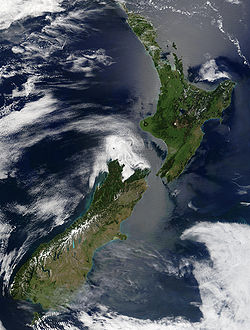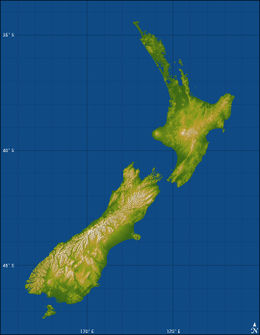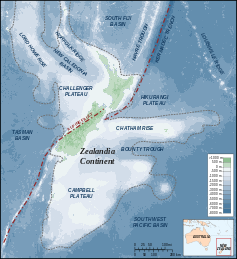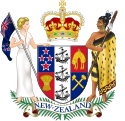Geography of New Zealand
| Geography of New Zealand | |
 |
|
| Continent | Zealandia |
| Region | Oceania |
| Coordinates | |
| Area | Ranked 75th 268,680 km² 103,738 miles² 97.9% land 2.1% water |
| Coastline | 15,134 km 9,398 miles |
| Borders | 0 km |
| Highest point | Aoraki/Mount Cook 3,754 m (12,316 ft) |
| Lowest point | Pacific Ocean 0 m |
| Longest river | Waikato River |
| Largest lake | Lake Taupo |
The geography of New Zealand encompasses two main islands (the North and South Islands, Te-Ika-a-Maui and Te Wai Pounamu in Māori) and a number of smaller islands, located near the centre of the water hemisphere. New Zealand varies in climate, from cold and wet to dry and to subtropical in some areas. The dramatic and varied landscape of New Zealand has made it a popular location for the production of television programmes and films, including the Lord of the Rings trilogy.
Neighbouring countries include Australia to the northwest and Tonga and Fiji to the north.
Contents |
Physical geography
New Zealand is in Oceania, in the South Pacific Ocean at . It has an area of 268,680 square kilometres (103,738 sq. mi) (including Antipodes Islands, Auckland Islands, Bounty Islands, Campbell Islands, Chatham Islands, and Kermadec Islands), making it slightly smaller than Italy and Japan and a little larger than the United Kingdom. These islands are the main areas of land that emerged from the largely submerged continent of Zealandia.
New Zealand has 15,134 km (9,398 mi) of coastline and extensive marine resources. The country claims the seventh-largest Exclusive Economic Zone in the world, covering over four million square kilometres (1.5 million sq mi), more than 15 times its land area.[1] It has no land borders.
The South Island is the largest land mass and contains about one quarter of the population. The island is divided along its length by the Southern Alps, the highest peak of which is Aoraki/Mount Cook at 3754 metres (12,316 ft). There are 18 peaks of more than 3000 metres (9800 ft) in the South Island. The east side of the island has the Canterbury Plains while the West Coast is famous for its rough coastlines, very high proportion of native bush, and Fox and Franz Josef Glaciers.
The North Island is less mountainous than the South, and is marked by volcanism. The island's tallest mountain, Mount Ruapehu (2797 m / 9176 ft), is an active cone volcano. Lake Taupo is near the centre of the North Island and is the largest lake by surface area in the country. It lies in a caldera created by the largest eruption in the world in the past 70,000 years (see Oruanui eruption).
Geology


New Zealand straddles the boundary between two tectonic plates. The subduction of the Pacific plate under the Indo-Australian Plate results in volcanism, especially in the North Island's Taupo Volcanic Zone. The associated geothermal energy is used in numerous hydrothermal power plants.[2] Some volcanic places are also famous tourist destinations, such as the Rotorua geysers.
The collision between the two plates causes regular earthquakes, though severe ones are infrequent. These have uplifted the Southern Alps along the Alpine Fault, and the resulting orographic rainfall enables the hydroelectric generation of most of the country's electricity.[3] New Zealand experiences around 14,000 earthquakes a year,[4] some in excess of magnitude 7.
There are karst sedimentary rock formations, the largest area being Takaka Hill and surrounding area, and others include the Waitomo Caves and the Pancake Rocks which are recognised tourist attractions.
Political geography
New Zealand consists of 16 regions, seven in the South Island and nine in the North, and a number of outlying islands that are not included within regional boundaries. The Chatham Islands is not a region, although its council operates as a region under the Resource Management Act. The Kermadecs and the sub-Antarctic islands are inhabited only by a small number of Department of Conservation staff.
Climate
The climate is mostly cool temperate to warm temperate. Mean temperatures range from 8°C (46°F) in the South Island to 16 °C (61 °F) in the North Island.[5] January and February are the warmest months, July the coldest. New Zealand does not have a large temperature range but the weather can change rapidly and unexpectedly. Subtropical conditions are experienced in Northland.
Most areas of the country have between 600 and 1600 mm of rainfall, with the most rain along the west coast of the South Island and the least on the east coast of the South Island, predominantly on the Canterbury Plains. Christchurch is the driest city, receiving about 640 mm (25 in) of rain per year, while Auckland is the wettest, receiving almost twice that amount.
New Zealand's UV index can be very high in some places and extreme in the hottest times of the year in the north of the North Island. This is partly due to the country's relatively little air pollution compared to many other countries.
There are three main factors that influence New Zealand's climate:[6]
- the latitude, with prevailing westerly winds;
- the oceanic environment.
- the mountains, especially the Southern Alps.
Land use
Natural resources include: coal, gold, hydropower, iron ore, limestone, natural gas, sand, and timber.
Land use:[7]
- arable land: 5.54%
- permanent crops: 6.92%
- other: 87.54%
Irrigated land: 2,850 km² (2003)
Natural hazards
- Earthquakes are common, though usually not severe
- Volcanic activity
- Fire bans exist in some areas
Environment
Current issues: Deforestation, soil erosion, native flora and fauna hard-hit by invasive species.
International agreements:
- party to: Antarctic-Environmental Protocol, Antarctic-Marine Living Resources, Antarctic Treaty, Biodiversity, Climate Change, Climate Change-Kyoto Protocol, Desertification, Endangered Species, Environmental Modification, Hazardous Wastes, Law of the Sea, Marine Dumping, Ozone Layer Protection, Ship Pollution, Tropical Timber 94, Wetlands, Whaling
- signed, but not ratified: Marine Life Conservation, Antarctic Seals
.jpg)
See also
- Extreme points of New Zealand
- Islands of New Zealand
- Lakes of New Zealand
- New Zealand Map grid
- Rivers of New Zealand
- Water hemisphere
References
- ↑ Ministry for the Environment. 2005. Offshore Options: Managing Environmental Effects in New Zealand's Exclusive Economic Zone. Introduction
- ↑ Matthew Hall (2004) Existing and Potential Geothermal Resource for Electricity Generation. Ministry for Economic Development.
- ↑ About 58% of New Zealand's electricity was hydroelectric in 2002. Veronika Meduna. 'Wind and solar power', Te Ara - the Encyclopedia of New Zealand, updated 21 September 2007.
- ↑ Radio NZ news report on 2007 Gisborne earthquake
- ↑ From NIWA Science climate overview.
- ↑ Statistics New Zealand page
- ↑ From CIA World Factbook, 2006 edition.
External links
- Statistics New Zealand
- Provincial political map
- Showcaves.com NZ geology
- New Zealand's Geological History - 1966 Encyclopaedia of New Zealand
- Seafloor Geology, Encyclopedia of New Zealand
- The History of the Mapping of New Zealand
|
||||||||||||||||||||||||||||||||
|
|||||||||||
